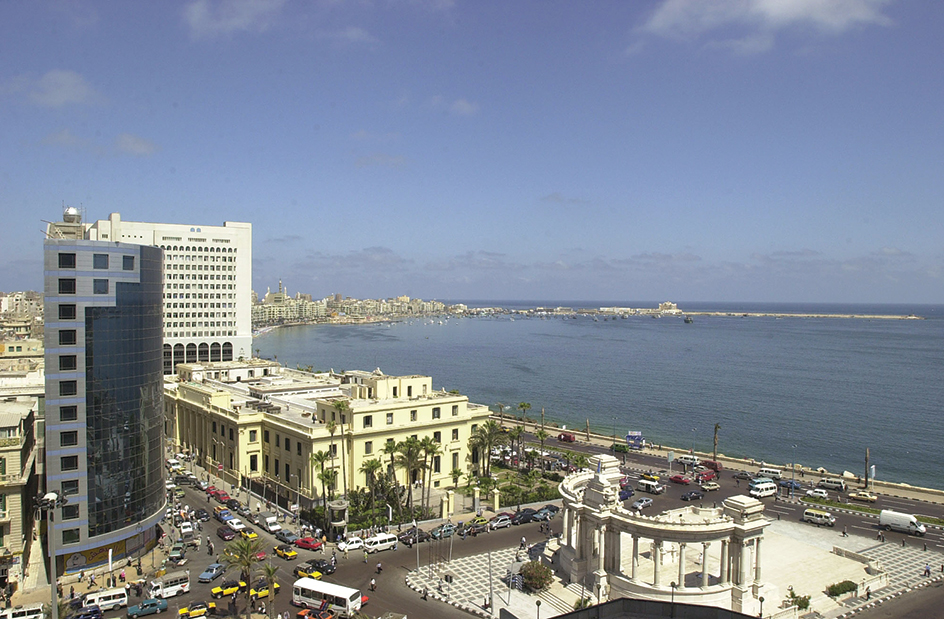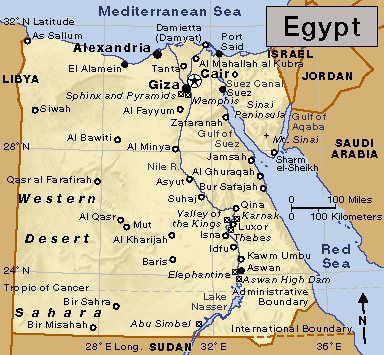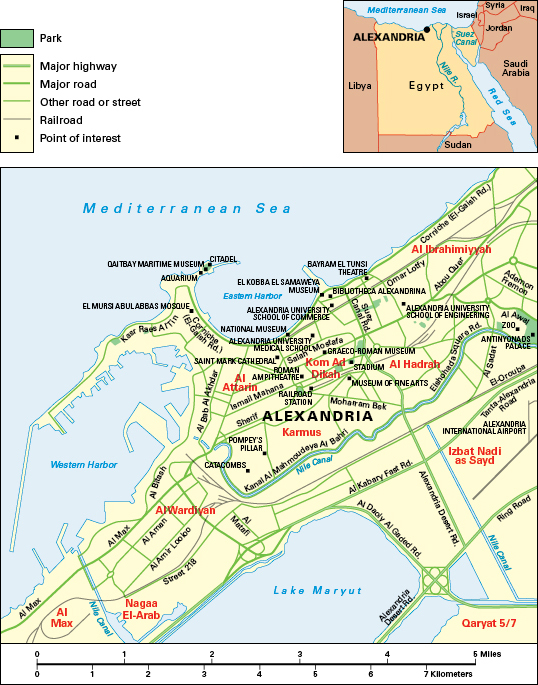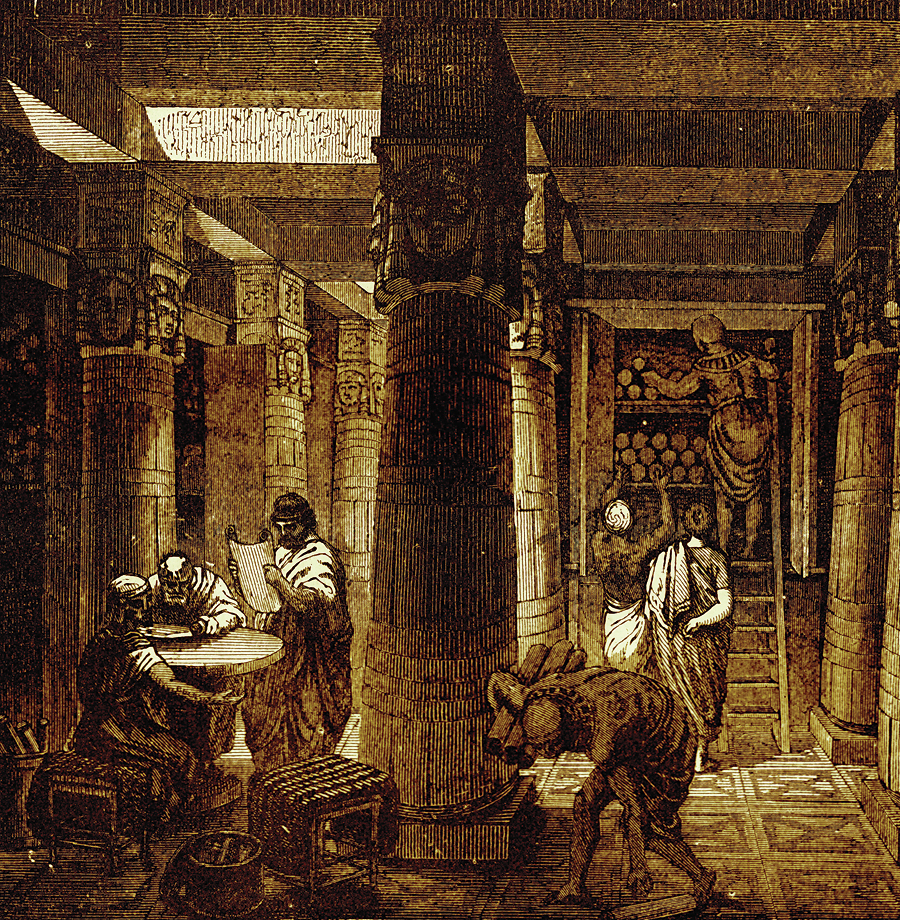Alexandria (pop. 4,939,093) is Egypt’s busiest seaport and second largest city. Only Cairo, Egypt’s capital, has more people. Alexandria is also a major industrial center. The city lies on Egypt’s Mediterranean coast in the northwest corner of the Nile Delta, a fertile agricultural area. In ancient times, Alexandria was one of the world’s most important commercial and cultural centers. 
The city
is built on a long isthmus (strip of land) between Lake Maryut and the Mediterranean Sea. A hammer-shaped peninsula extends out from the isthmus and forms two large harbors, east and west. These magnificent harbors have made Alexandria one of the Mediterranean’s leading ports for thousands of years. 
Hotels and beaches line the Corniche, a broad, curving road along the city’s shoreline. The city is the home of Alexandria University. The Bibliotheca Alexandrina, a large research library that opened in 2002, is a revival of Alexandria’s great ancient library.
People.
Almost all of Alexandria’s people are Egyptians. Most of the Egyptians are Muslims who speak Arabic. A small number of foreigners live in the city.

In general, Alexandria’s upper- and middle-class residents live in the east part of the city. Most working-class people live on the west side close to industrial areas, and on the peninsula between the two harbors. Most residents live in large apartment complexes.
Economy.
Manufacturing plants in or near the city produce petroleum products, plastics, processed foods, steel, textiles, and other goods. Tourism also contributes to the city’s economy. Huge numbers of vacationers come to Alexandria each summer to take advantage of the city’s beaches and resorts.
History.
Alexandria is named after Alexander the Great, the king of Macedonia, who founded the city in 331 B.C. after conquering Egypt. After Alexander died in 323 B.C., one of his generals, Ptolemy, took over Egypt’s government and founded the dynasty known as the Ptolemies. Ptolemy made Alexandria the capital of Egypt.
Under the reign of the Ptolemies, Alexandria thrived. It was one of the great centers of trade and culture, and its population was the largest of any Mediterranean city. Many of the leading thinkers of the Greek-speaking world worked in the city. The towering Lighthouse of Alexandria was one of the Seven Wonders of the Ancient World. The city had a scientific institute called the Mouseion and a library with about 500,000 scrolls made of an early form of paper called papyrus. These institutions conserved and developed the science, literature, philosophy, and religious culture of the ancient world.


The Ptolemaic dynasty ended when its last ruler, Cleopatra, rebelled against the growing power of Rome. After her failure to defend Egypt’s independence, she killed herself in 30 B.C. Egypt was then made part of the Roman Empire. Under the Romans, Alexandria remained an important trade center. It also was a major center for the processing of gold and silver and the production of glass, jewelry, linen, and papyrus.
According to tradition, Saint Mark, a Christian missionary, founded the Egyptian (Coptic) church in Alexandria around A.D. 40. The city, which already had a large community of Jews, soon also developed a thriving Christian community. Bishops of Alexandria exercised enormous influence in defining beliefs and practices of the new Christian faith.
During Roman rule, clashes often took place between rival ethnic and religious groups in the city. In the late 200’s, the Mouseion and library were destroyed during a war over control of the Roman Empire. When the Roman Empire was divided in 395, Egypt became part of the Byzantine Empire.
In 642, Arab Muslims conquered Egypt. The Arabs moved the capital from Alexandria to what is now Cairo. Alexandria’s population gradually declined, and the city ceased to be a cultural center. In 1517, Egypt became part of the Ottoman Empire, which was based in what is now Turkey. Under Ottoman rule, Alexandria’s population fell sharply.
In 1805, an Ottoman army officer named Muhammad Ali was appointed governor of Egypt. Under Muhammad Ali and his successors, Alexandria again grew to be a center of business, banking, and trade. In 1820, a canal connecting Alexandria to the Nile River was completed. A railroad linking Alexandria to Cairo was built in the 1850’s.
The city’s population grew rapidly in the 1800’s. Most of the new residents were Egyptian Muslims. But large numbers of immigrants from other countries also came to the city. Many of these foreigners became important business leaders. Tensions rose between the city’s Egyptian and foreign communities, and bloody riots took place in 1882. Later that year, British warships bombarded the city, and British troops occupied Egypt. The British acted to crush a movement for Egyptian self-government, protect foreigners, and further British influence in the region. Foreign business interests strengthened their control of Alexandria in the late 1800’s and early 1900’s.
After Egypt gained independence from the United Kingdom in 1922, foreign control over the city weakened. By the 1950’s, most foreigners had left Alexandria. During the 1950’s and 1960’s, rapid industrial development took place in the city.
In the 1990’s, archaeologists working in waters near Alexandria found hundreds of granite blocks, huge statues, and other stonework belonging to the ancient lighthouse, which had collapsed during an earthquake in the 1300’s. The archaeologists also found about 40 sunken ships, which showed the wide range of Alexandria’s early commercial activity.
